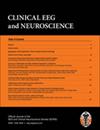DBS患者异常的脑电图伪影。
IF 1.6
4区 医学
Q3 CLINICAL NEUROLOGY
Clinical EEG and Neuroscience
Pub Date : 2022-11-01
Epub Date: 2021-12-03
DOI:10.1177/15500594211063710
引用次数: 1
摘要
本文章由计算机程序翻译,如有差异,请以英文原文为准。
Unusual EEG Artifact in Patients with DBS.
Use of deep brain stimulation (DBS) technology has expanded over the past decade and is currently employed for treatment of various movement disorders such as Parkinson disease, tremors, dystonia, and epilepsy. A high frequency artifact has been well described on electroencephalograms (EEGs) of patients with DBS and is considered a result of the electrical nature of the stimulation. We present 3 cases of an unusually slow frequency and rhythmic artifact in DBS patients. This unfamiliar artifact could be mistaken for an ictal pattern, especially in patients with altered sensorium. Recognition of this novel artifact will minimize misinterpretation and potential unnecessary treatment.
求助全文
通过发布文献求助,成功后即可免费获取论文全文。
去求助
来源期刊

Clinical EEG and Neuroscience
医学-临床神经学
CiteScore
5.20
自引率
5.00%
发文量
66
审稿时长
>12 weeks
期刊介绍:
Clinical EEG and Neuroscience conveys clinically relevant research and development in electroencephalography and neuroscience. Original articles on any aspect of clinical neurophysiology or related work in allied fields are invited for publication.
 求助内容:
求助内容: 应助结果提醒方式:
应助结果提醒方式:


